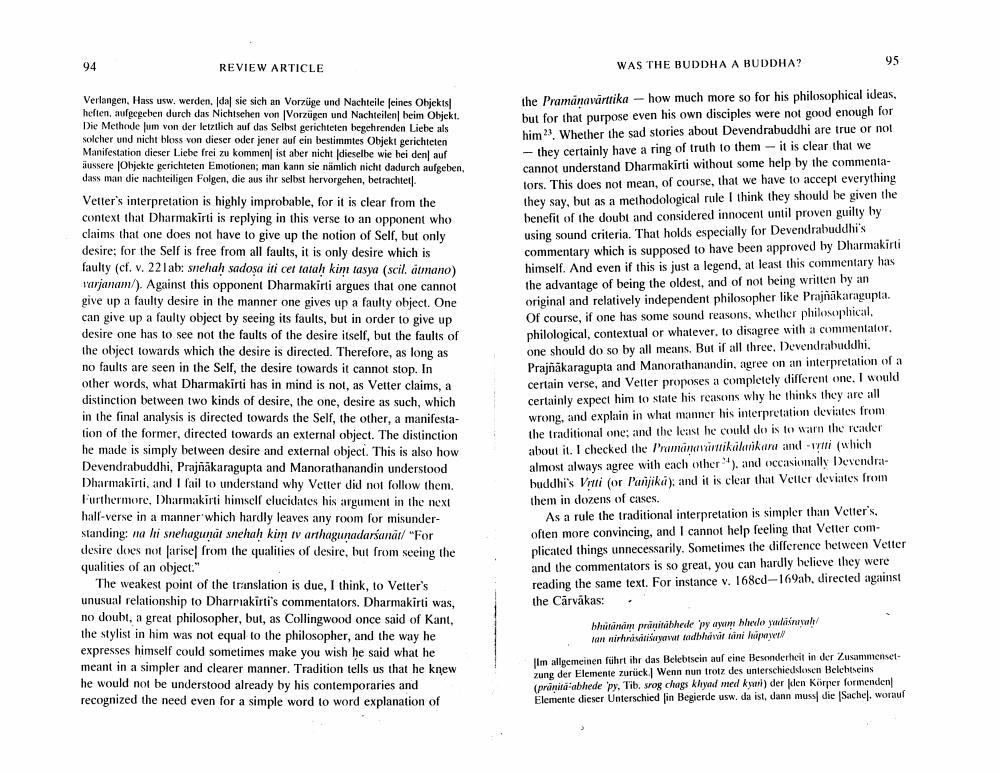Book Title: was The Buddha A Buddha Author(s): Eli Franco Publisher: Eli Franco View full book textPage 8
________________ WAS THE BUDDHA A BUDDHA? REVIEW ARTICLE 95 Verlangen, Hass usw. werden, da sie sich an Vorzüge und Nachteile eines Objekts heften, aufgegeben durch das Nichtsehen von Vorzügen und Nachteilen beim Objekt. Die Methode fum von der letztlich auf das Selbst gerichteten begehrenden Liebe als solcher und nicht bloss von dieser oder jener auf ein bestimmtes Objekt gerichteten Manifestation dieser Liebe frei zu kommen ist aber nicht dieselbe wie bei den auf aussere Objekte gerichteten Emotionen; man kann sie nämlich nicht dadurch aufgeben. dass man die nachteiligen Folgen, die aus ihr selbst hervorgehen, betrachtet Vetter's interpretation is highly improbable, for it is clear from the context that Dharmakirti is replying in this verse to an opponent who claims that one does not have to give up the notion of Sell, but only desire; for the Self is free from all faults, it is only desire which is faulty (cf. v. 221 ab: snehah sadosa iti cel tatah kim tasya (scil. atmano) varjanam/). Against this opponent Dharmakirti argues that one cannot give up a faulty desire in the manner one gives up a faulty object. One can give up a faulty object by seeing its faults, but in order to give up desire one has to see not the faults of the desire itself, but the faults of the object towards which the desire is directed. Therefore, as long as no faults are seen in the Self, the desire towards it cannot stop. In other words, what Dharmakirti has in mind is not, as Vetter claims, a distinction between two kinds of desire, the one, desire as such, which in the final analysis is directed towards the Self, the other, a manifestation of the former, directed towards an external object. The distinction he made is simply between desire and external object. This is also how Devendrabuddhi, Prajnakaragupta and Manorathanandin understood Dharmakirti, and I fail to understand why Vetter did not follow them. Furthermore, Dharmakirti himsell elucidates his argument in the next half-verse in a manner which hardly leaves any room for misunderstanding: na li snehugunāt snehah kim iv arthagunadaršunát/ "For desire does not farise from the qualities of desire, but from seeing the qualities of an object." The weakest point of the translation is due, I think, to Vetter's unusual relationship to Dharriakirti's commentators. Dharmakirti was, no doubt, a great philosopher, but, as Collingwood once said of Kant, the stylist in him was not equal to the philosopher, and the way he expresses himself could sometimes make you wish he said what he meant in a simpler and clearer manner. Tradition tells us that he knew he would not be understood already by his contemporaries and recognized the need even for a simple word to word explanation of the Pramanavirttika - how much more so for his philosophical ideas, but for that purpose even his own disciples were not good enough for him . Whether the sad stories about Devendrabuddhi are true or not - they certainly have a ring of truth to them -- it is clear that we cannot understand Dharmakirti without some help by the commentators. This does not mean, of course, that we have to accept everything they say, but as a methodological rule I think they should be given the benefit of the doubt and considered innocent until proven guilty by using sound criteria. That holds especially for Devendrabuddhi's commentary which is supposed to have been approved by Dharmakirti himself. And even if this is just a legend, at least this commentary has the advantage of being the oldest, and of not being written by an original and relatively independent philosopher like Prajñākaragupta. Of course, if one has some sound reasons, whether philosophical philological contextual or whatever, to disagree with a commentator. one should do so by all means. But if all three, Devendrabuddhi. Prajñākaragupta and Manorathanandin, agree on an interpretation of a certain verse, and Vetter proposes a completely different one. I would certainly expect him to state his reasons why he thinks they are all wrong, and explain in what manner his interpretation deviates from the traditional one; and the least he could do is to warn the reader about it. I checked the Prunin ikilarikan andhi (which almost always agree with each other.), and occasionally Devendrabuddhi's Vuli (or Panjika), and it is clear that Velter deviates from them in dozens of cases. As a rule the traditional interpretation is simpler than Vetter's, often more convincing, and I cannot help feeling that Velter complicated things unnecessarily. Sometimes the difference between Vetter and the commentators is so great, you can hardly believe they were reading the same text. For instance v. 168cd-169ah, directed against the Cārvākas: bhutánam pranitobhede 'py uyum hlelo linal/ tan nirhristiawat tadbheir fani linier Ilm allgemeinen führt ihr das Belebisein auf eine Besonderheit in der Zusammenset zung der Elemente zurück. Wenn nun trotz des unterschiedslosen Belchtseins (prvinita abhede 'py, Tib, srog chags khyand med kil) der Klen Körper formenden! Elemente dieser Unterschied sin Begierde usw. da ist, dann muss die Sachel, worauf ick/ w. plebisein e DPage Navigation
1 ... 6 7 8 9 10
